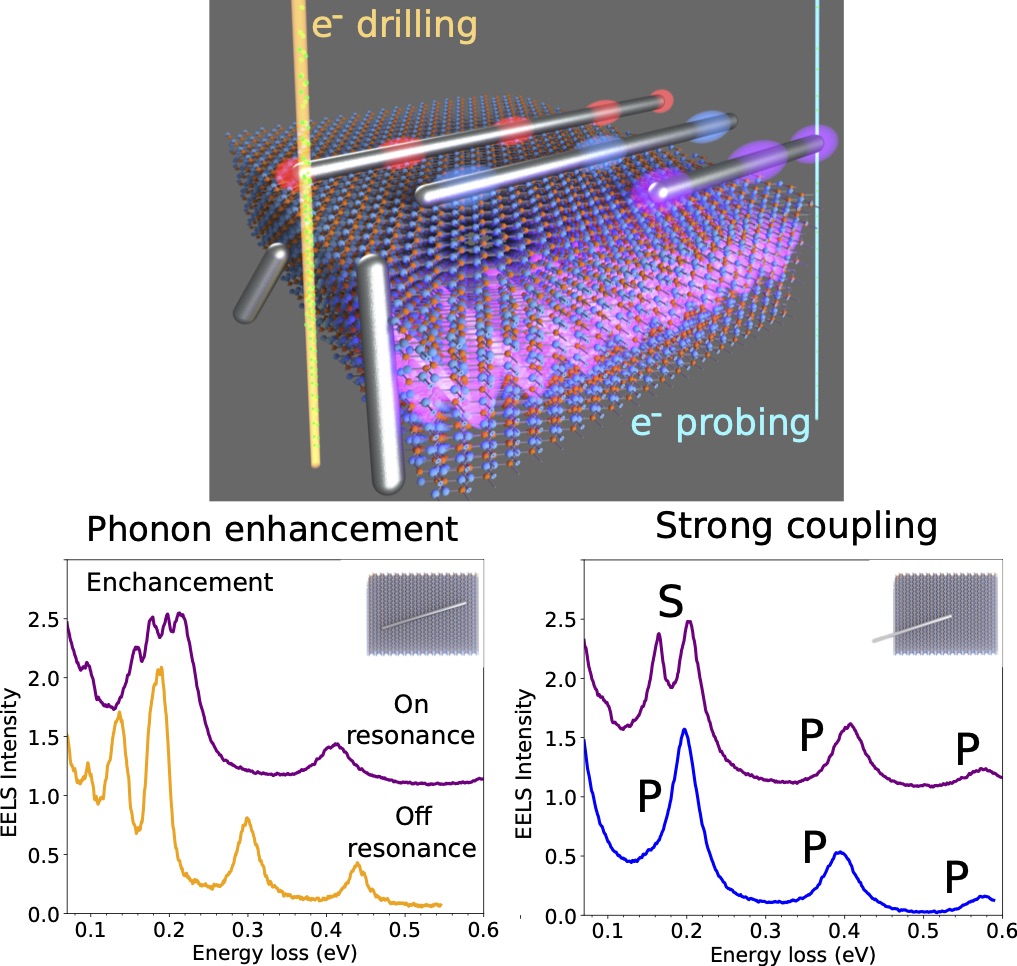The LPS STEM group and their collaborators have unveiled the interaction of phonons and plasmons at the nanometer scale. This interaction, which is discussed in an article just published in Nano Letters, could only be discovered thanks to recent technological advances that made it possible to generate electron beams of the order of nanometre width with very narrow spectral resolution (< 10 meV). A microscope equipped with this technology, called ChromaTEM (project TEMPOS ANR), capable of probing phonons at high spatial resolution is installed at the LPS.
Phonons are vibrations of atoms inside materials, while plasmons are collective oscillations of electrons. In this work, phonons of thin layers of hBN (hexagonal boron nitride) and plasmons of silver nanowires have been used. In order to couple phonons and plasmons efficiently, their energies must match. To achieve this, the length of the silver nanowires was modified by cutting the nanowires with a high-energy electron beam, to an accuracy of the order of 10 nm (a dimension about 1000 times smaller than the thickness of a typical human hair). Indeed, the energy of a plasmon varies, as a first approximation, as the inverse of the length of the underlying nanowire.
Two signatures were expected in the Electronic Energy Loss Spectrum (EELS) if the energy of the plasmons matches that of the plasmon. The first one is an enhancement of the phonon signature due to the presence of the plasmon. The second is a change in energy levels.
The interaction of phonons with plasmons has been widely explored in the past. Indeed, it allows one to reach an extreme sensitivity, which goes up to the detection of single molecules, in Raman (SERS, surface enhanced Raman spectroscopy) and optical absorption (SEIRA, surface-enhanced infrared absorption) experiments. In these experiments, the high local density of electromagnetic states provided by the plasmon enhances the phonon signals and allows the detection of individual molecules. The STEM group discovered a similar effect in EELS: the enhancement of vibrational signals due to the presence of plasmons. This effect, called PEVES (plasmon-enhanced vibrational EELS) had been predicted in the past. However, it had not been observed experimentally. More specifically, it has been shown that it is possible to detect with this method phonon modes which are not generally observed in EELS, either for reasons of signal-to-noise ratio or for reasons of symmetry. This was experimentally visualized for thin layers of hBN whose phonons were revealed by the presence of a plasmonic mode in silver nanowires of micrometer length. These experiments pave the way for the possibility of obtaining exalted molecular signatures in EELS, bringing together in the same experiment all the advantages of vibrational spectroscopy and the very high resolution imaging of electron microscopy for molecule identification.
Due to the intense field density of the states, the STEM group also observed strong coupling of phonons and plasmons. The observation of the strong coupling across the entire nanowire proves that phonon-plasmon hybrid modes are indeed spatially coherent throughout the nanostructure.

Reference
Tailored nanoscale plasmon-enhanced vibrational electron spectroscopy
L. H. G. Tizei, V. Mkhitaryan, H. Lourenço-Martins, L. Scarabelli, K. Watanabe, T. Taniguchi, M. Tencé, J.-D. Blazit, X. Li, A. Gloter, A. Zobelli, F. Schmidt, L. M. Liz-Marzán, F. Javier García de Abajo, O. Stephan & M. Kociak
Nano Letters 20, 5, 2973-2979 (2020)
doi:10.1021/acs.nanolett.9b04659
